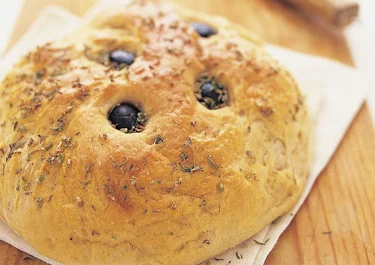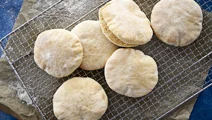Olive bread

Olive bread is a delightful choice for summer dinners and picnics. The aromatic and flavourful bread brings together the great taste of olives and the fragrant notes of herbaceous thyme, creating a perfect harmony with strong Mediterranean influences. Whether you are planning a gathering for friends and family or want to enjoy a relaxing picnic amidst nature's beauty, this olive bread is sure to elevate your dining experience. So, roll up your sleeves, gather your ingredients, and embark on a culinary journey that captures the essence of summertime bliss.
Ingredients
|
Yeast
|
50 g |
|---|---|
|
Lukewarm water
|
500 ml |
|
Butter
|
25 g |
|
Salt (approx.)
|
1½ tsp |
|
Honey
|
2 tbsp |
|
Quark 0.3%
|
250 g |
|
Fine rye flour
|
200 ml |
|
Wheat flour
|
750 g |
|
Black olives
|
30 |
|
Beaten egg
|
1 |
|
Dried thyme
|
2 tsp |
|
Melted butter
|
2 tbsp |
Instructions
Tips
Letting the dough proof adequately is crucial for achieving optimal flavour and texture in your olive bread. The dough should approx. double in size and appear visibly puffy after its first rise. Gently poke the dough with your finger, and if the indentation remains without springing back completely, it is an indication that the dough has risen sufficiently.
Tips
Remember that the temperature impacts the proofing time. If your kitchen is on the cooler side, you may need to provide a longer proofing time. On the other hand, in a warm environment, the dough may rise more quickly. It is important to be flexible and allow the dough to rise until it has visibly increased in size, even if it takes slightly longer than the recommended time.
Questions about olive bread
With an easy olive bread recipe, making a homemade loaf to bring along for a cosy picnic at the park is no big deal. To learn more about olive bread, have a look at the answers to some frequently asked questions about it below.
How to make olive bread?
Start by dissolving crumbled yeast in lukewarm water. Add butter, salt, honey, quark, and flour and work the dough until it is smooth. Cover and let it proof. Start preheating the oven as you shape two loaves on a floured surface. Place them on a lined baking sheet, press olives into the surface, and leave to proof for a second time. Before baking the loaves, brush with beaten egg and sprinkle with dried thyme. Bake them and brush them with melted butter before allowing them to cool.
What to serve with olive bread?
Olive bread can be enjoyed in many tasty ways. Use it as a snack or appetizer as it is or serve it with a bit of high-quality olive oil the way you might enjoy it at a Mediterranean restaurant. It is also great as a side dish at a barbecue with a selection of salads and grilled meats and vegetables. It may, of course, also be enjoyed as a savoury side to pasta dishes or soups. Because it is easy to transport and may be served as it is, olive bread makes for a great picnic treat.
Can you freeze olive bread?
Yes, you can freeze olive bread for up to 2-3 months. Freezing is an excellent way to preserve its freshness and flavour for a longer period. Allow it to cool completely before freezing. Then, wrap it tightly in cling film or aluminium foil to protect it from freezer burn and to maintain its moisture. Alternatively, you can place the bread in a resealable freezer bag, removing as much air as possible before sealing. When you are ready to enjoy it, remove it from the freezer and let it thaw in the fridge overnight. Once thawed, you can refresh the crust and warm it up by placing it in a preheated oven at 150°C for a few minutes. This will help restore the texture and revive the flavours.
Try our easy recipe for olive bread
There is nothing like biting into a freshly baked loaf of olive bread. The golden-brown surface has a slight crunch to it while the crumb is tender and airy thanks to the fresh and tangy quark in the dough. While bread alone offers a mild and comforting taste, there is something extraordinary about those that bursts with bolder, more vibrant flavours.
In the case of olive bread, the journey to perfection begins with the addition of rich and salty olives pressed into the surface. As the bread bakes, these remarkable olives impart their savouriness, taking the loaves to new heights of deliciousness. The inherent richness and saltiness of the olives seep into the bread, infusing it with a distinct depth and complexity that is quite irresistible.
The olives also have a great tang to them. It works as a whisper of freshness that cuts through the richness and keeps each bite exciting, ensuring that every mouthful of this olive bread is flavourful and well-balanced.
Enjoy the distinct and aromatic flavour of thyme
On their own olives can be a bit overwhelming, however, with a well-selected herb, harmony and balance are ensured. This is why thyme is a wonderful choice.
Thyme has a distinctive herbal flavour that is often described as earthy and slightly minty. It also has a pleasant, savoury quality that adds depth to the overall taste experience of homemade olive bread. Its mild bitterness works well to complement the rich, salty olives while its woodsy qualities imbue the loaves with a delightful aroma.
Sprinkling with thyme is also a great way to introduce a bit of additional texture. The dried herbs provide a slight crunch to the surface of the bread, enhancing its own light crispness.
An essential part of your picnic basket
A picnic basket may be filled with many great dishes like Spinach quiche and pasta salad that are easy to transport and can be served cold. But it does not feel complete without at least one great bread-based dish. While you can, of course, opt for something like sandwiches, olive bread is also a great choice. Its savoury flavour is a great side for plenty of other picnic recipes.
If you have a cosy backyard and spend a lot of time barbecuing or hosting friends and family, you can, of course, enjoy your homemade olive bread on these occasions as well. It works wonderfully as a side to a classic barbecue option like grilled spareribs. For an elevated garden party, we also suggest serving it to accompany a delightful salmon pasta – this way it may be used to soak up the delicious sauce.
Try different versions to find the best one for your taste
Olive bread recipes are incredibly easy to vary. One way to switch up the flavours without altering too much is to vary the type of olives you use. While black olives have a rich and salty flavour, greens ones are typically milder and can add more tang as well as a slightly briny flavour to the bread. Each will add something different and if you like both, you can even use a mix. You can also use stuffed olives, such as those filled with garlic, to bring an additional layer of flavour.
Instead of using just thyme, you can create your own Mediterranean herb blend to add a more diverse range of flavours to the olive bread. Combine dried thyme, dried rosemary, dried oregano, and dried basil in equal proportions. Add the herb blend to the dough to infuse it with great flavours that will make you dream of summer nights in Southern Europe. The combination of herbs will create a more complex and aromatic flavour profile.
For a richer and more indulgent twist, consider adding cheese to the olive bread with thyme. You can use grated parmesan, crumbled feta, or shredded mozzarella. If you like the distinct earthy flavour of goat cheese, this type will also work well. Either mix the cheese into the dough or sprinkle it on top of the loaves for the last few minutes of baking. The combination of cheese, thyme, and olives will create a savoury and flavourful bread with either a gooey, melted cheese interior or a loaf with melted cheese on top that can create a slightly crispy layer.


&format=webp)



&format=webp)

